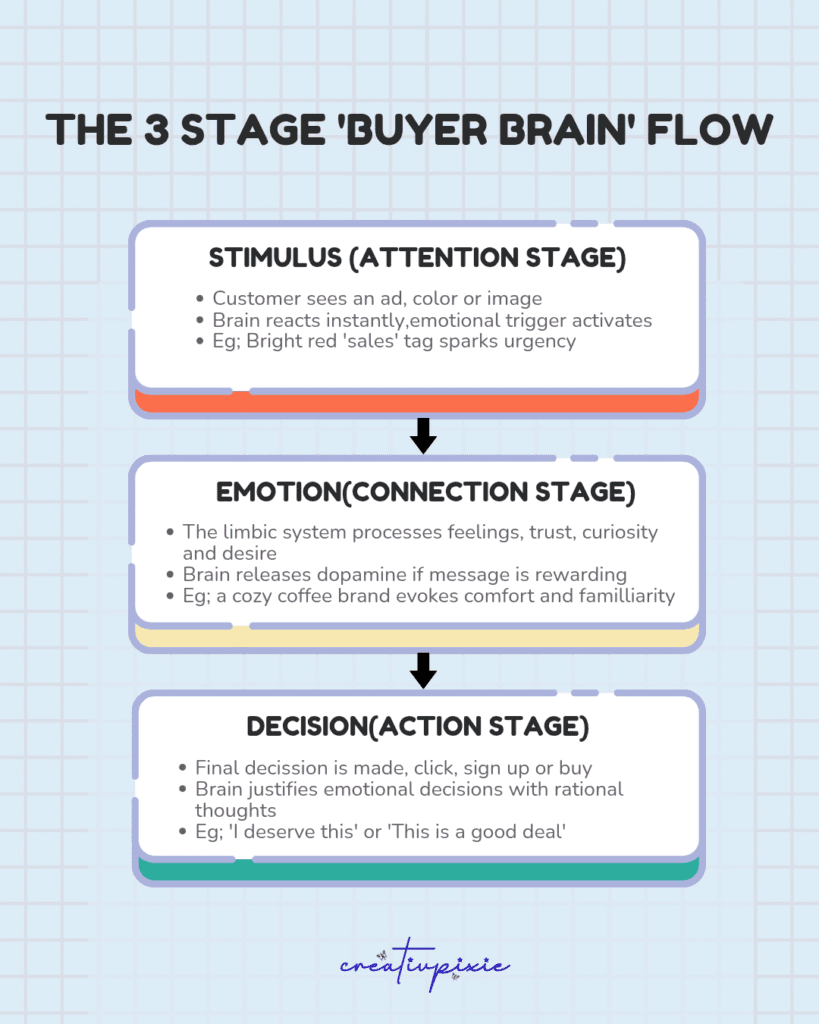Ever wondered how Psychology is a huge part of how you end noticing something on your Instagram feed when you were just thinking about it for a while ago? That’s how successful marketing works. It isn’t just about creativity but about understanding the brain behind the buyer. What you think, how you feel, your certain preferences, the way you liker certain things etc. That’s where Neuro Marketing : Consumer Psychcology in Digital Marketing comes in place. A serious blend of psychology, science and data to help brands connect with you on an emotional level.
“The secret behind great marketing isn’t just plain data, it is emotions”
What is Neuro-Marketing?
Neuro-marketing is the usage of consumer psychology in Digital Marketing. That is, the study of how a consumer’s brain responds to marketing stimuli that includes colors, shapes, sounds, words or even the shape of a product. It is about how fast people click ‘buy now’ instantly for a product or maybe ‘add to cart’ for thinking about buying it later.
Marketers use this unique science to craft products or experience that don’t just sell but one that resonate with you emotionally.

The Psychology Behind Consumer Decisions
- Emotion over logic: Atleast 90% of the purchases are driven by emotions. Yes! Remember the last time you bought something just because it reminded you of your childhood? Maybe a certain candy? An experience long forgotten? It can be a relatable story, a sense of belonging, or maybe the instant trigger of happiness that it gives you which creates the ‘yes I want it now’ factor.
- Color Psychology: Each colour denotes something and marketers know it colors play well with our minds. Let’s take for example; the colour Red ignites a sense of urgency and passion, Blue builds trust and signals purity whereas Yellow sparks positivity and happiness. Think of a few products which you might be constantly purchasing using color psychology without you even noticing.
- FOMO (Fear of missing out): Haven’t we all seen trends like labubu dolls and certain limited edition products? Sometimes I realize what are even the point of selling such products, I mean labubus look evil to me. But there comes the ‘only 3 left in stock’ or ‘limited time offer’ from the sellers. Our brain signals scarcity or the need for this product immediately. Such an urgency drives conversion. We all can agree we all have fallen for this before. Maybe I might have too. Pst.
- The Social Proof: Don’t we all when searching for a product online read reviews from previous customers? That builds a sort of trust for us to buy a product. Lo and behold how reviews, testimonials or any customer-related content creates trust. Seeing other people like something or rave about it, nudges you as a new customer to follow that lead which in turn generate sales. Certainly a review a day saves the marketer a pay delay. Did that sound too… silly? No worries, we live in a universe where everything sells
Examples of brands using Neuro-Marketing
Ikea’s Endowment effect : Making you assemble your own furniture, not just cost-saving but psychological too! The more you invest time into the product, the more you value it. Let’s not forget how we have to walk past the whole of Ikea to get one single thing; and end up getting a lot more.
Apple’s simplicity effect: Minimal visuals, lots of white space and calm visuals giving no space for cognitive clutter and a let’s not forget the very kept brand image.
Coco-cola’s happiness trigger : From the ads having the sound of bottle opening to using the word ‘happiness’ constantly, the company trains the brain to associate their brand to “feel good” moments.
Netflix’s predictive pleasure : Haven’t we all associated the sound ‘ta-dum’ to Netflix? Once you finish a series, you get animated previews for the next one making sure your brain keeps wanting more ‘I want to relax’ options to watch.
“People don’t buy products ; they buy the feelings these products promise”
How you can apply Neuro-Marketing to your brand:
- Include methods of storytelling to create emotional hooks with customers
- Choose brand colors wisely and that aligns with the message of your brand
- Instill human touches like visuals ; people connect when they see people
- Create an urgency but subtly without overdoing it
- Optimize your UX design so your brand looks appealing and effortless
- Provide small emotional gestures to connect with your customers
Final thoughts
Neuro-Marketing keeps reminding us that people aren’t just buying certain products but the feelings that come along with it. The more you try to understand your customer’s mind, the easier it gets for you to engage, connect and create products or service for them that connect with them emotionally. The more feelings your product has, the more loyal customers you win.
So, next time you’re designing an online campaign, just remember for once
“What emotion am I triggering for people?”
That’s the real secret to driving clicks and certainly conversions.
Ready to apply Neuro-marketing to your brand?
Firstly, I hope Neuro Marketing : Consumer Psychcology in Digital Marketing was an interesting read. It was definitely an interesting research for me since I love combining both Human Psychology and Digital Marketing.
Let’s connect and start creating campaigns and insights that speak to your customers in the language they love to hear and sell strategies that don’t just sell, but connect deeply.
What are other ways you think consumer psychology works in Digital Marketing? Comment down your thoughts below and let’s talk Neuro-Marketing!
